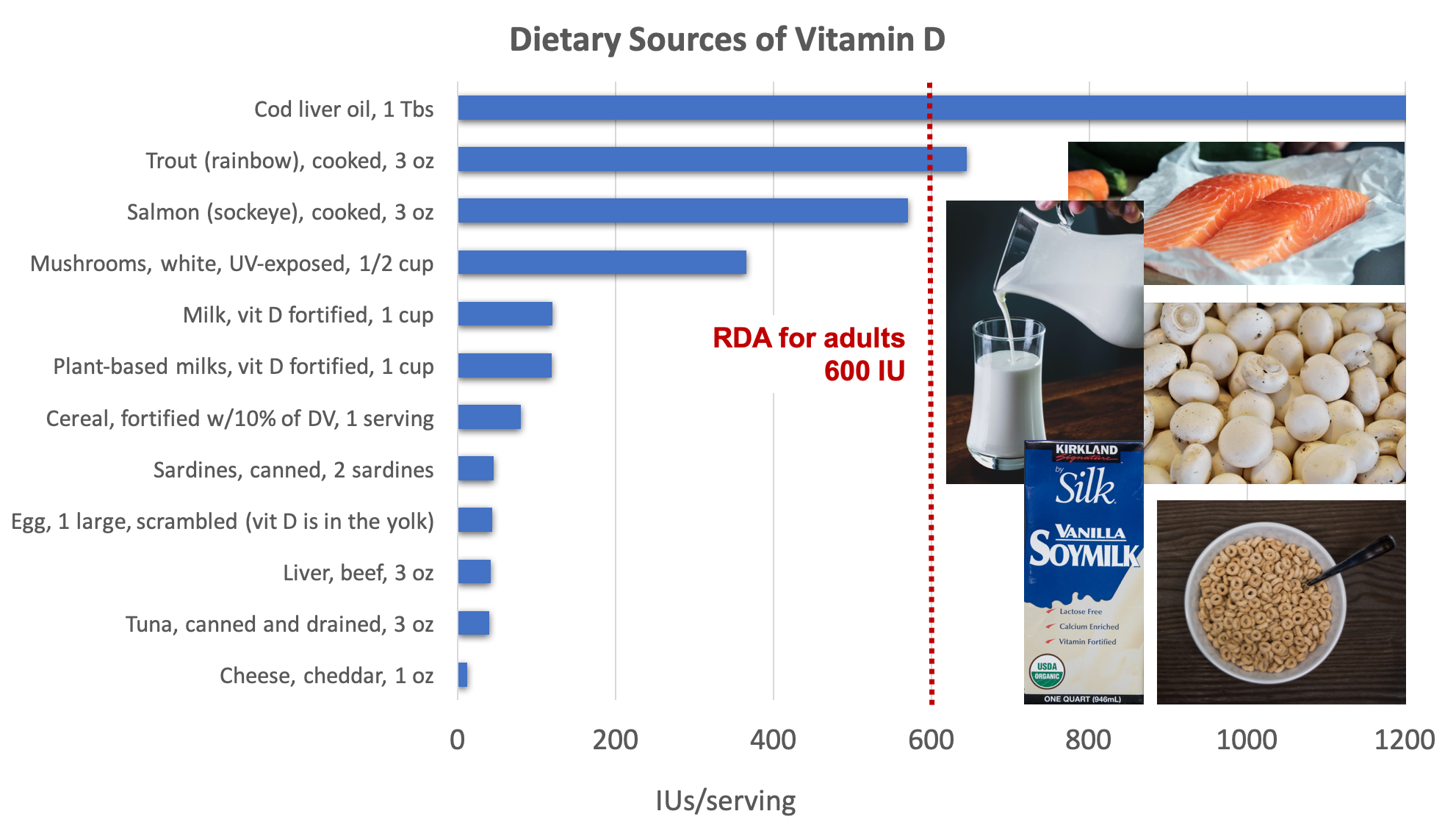Unit 9 – Vitamins and Minerals Part 2
9. 5 Vitamin D: Important to Bone Health and Beyond
Vitamin D is unique among the vitamins because we can synthesize most of what we need in our skin. Sunlight is an essential ingredient in this process, so vitamin D is sometimes called the “sunshine vitamin.” However, the amount of vitamin D synthesized in the body is often insufficient to meet our needs, so many people also need to consume dietary sources.
Metabolism and Functions of Vitamin D
Vitamin D synthesis in the skin begins with the conversion of cholesterol to previtamin D. Then, in the presence of ultraviolet (UV) rays from sunlight, it’s converted to vitamin D, which is transported to the liver.
Did you wonder the difference between vitamin D2 vs D3
Vitamin D2 (ergocalciferol) is the plant source of the vitamin derived from yeast and some plants, such as mushrooms. Humans and other animals make Vitamin D3 (cholecalciferol).
To be used by the body, vitamin D must be activated by enzymes located in our livers and kidneys, as noted in the diagram below.

Figure 9.9. Vitamin D can be synthesized in the skin or provided in the diet. It is converted by reactions occurring first in the liver (making calcidiol) and then the kidney (making calcitriol, the active form). Once active, vitamin D works in several ways to ensure blood calcium homeostasis and enhance the availability of calcium for bone mineralization.
Beyond its role in bone health, vitamin D has many other functions in the body. Some studies show that the vitamin reduces risks of cancer, diabetes, cardiovascular disease, and multiple sclerosis. However, it has been difficult to determine if a lack of vitamin D actually contributes to the cause of these diseases, and research in this area is ongoing.1
Sunlight as a Source of Vitamin D
Exposure to sunlight provides the majority of their body’s needs, and a little sun exposure can go a long way. Vitamin D researchers suggest that most people need between 5 and 30 minutes of sun exposure between 10 AM and 3 PM, at least twice per week, to synthesize adequate vitamin D. However, any factor that decreases exposure to UV rays can interfere with vitamin D synthesis.2
With so many factors affecting UV radiation exposure, many people cannot synthesize enough vitamin D for at least part of the year. Because vitamin D is fat-soluble, liver and adipose storage can supply the body for a while. Beyond that, dietary sources and supplements may be needed to meet the vitamin D requirement.2
Dietary Sources of Vitamin D
Only a few foods are naturally good sources of vitamin D. These include fatty fish such as salmon, tuna, and mackerel, as well as fish liver oil (e.g., cod liver oil). Smaller amounts are found in egg yolks, cheese, and beef liver. Additionally, some mushrooms grown in UV light can be a good source of vitamin D.
Most cow’s milk is fortified with vitamin D in the U.S. and Canada, but other dairy products such as ice cream and cheese are not. Fortified orange juice, soymilk and other plant-based beverages, and breakfast cereal can all contribute to dietary vitamin D intake, although amounts added vary significantly between products.2

Figure 9.10. Dietary sources of vitamin D. Source: Examples of good sources pictured include salmon, milk, mushrooms, fortified soy milk, and fortified cereal. NIH Office of Dietary Supplements
Human breast milk doesn’t contain adequate vitamin D, so the American Academy of Pediatrics recommends that breastfed infants receive a supplement with 400 IU of vitamin D per day until they have weaned to vitamin D-fortified formula or cow’s milk. A vitamin D supplement may also be recommended for older children and adults, depending on dietary intake and sun exposure, but this should be discussed with a healthcare provider.
Vitamin D Deficiency and Toxicity
In children, vitamin D deficiency causes rickets, a disease in which the bones are soft, weak, and deformed. Rickets was very common in the U.S. until the 1930s when FDA implemented the milk fortification program. Milk fortification has virtually eliminated rickets from the U.S. and other developed countries. However, rickets does still occur in breastfed infants and children raised on vegan diets who aren’t provided with other sources of vitamin D, particularly if they have darker skin pigmentation.1,3
Figure 9.11. Vitamin D deficiency in children causes rickets, a disease in which inadequate vitamin D leads to soft, weak, and deformed bones.
In adults, vitamin D deficiency causes osteomalacia, characterized by softening of bones, reduced bone mineral density, and increased risk of osteoporosis. Because bones are continuously remodeled throughout the lifespan, inadequate vitamin D limits the calcium available to rebuild bone tissue. Vitamin D deficiency can also cause bone pain and muscle weakness and pain, symptoms that can increase the risk of falling and fractures, particularly in older adults.2
Although vitamin D toxicity is rare, taking excessive amounts of vitamin D in supplement form can lead to hypercalcemia or high blood calcium. Hypercalcemia can cause kidney damage and calcium deposits to develop in soft tissues such as the kidneys, blood vessels, or other parts of the cardiovascular system. Synthesis of vitamin D from the sun does not cause vitamin D toxicity because vitamin D synthesis is tightly regulated and decreases if the body has abundant vitamin D.
Self-Check:
Attributions:
- Lane Community College’s Nutrition: Science and Everyday Application CC BY-NC.4.0
References:
- 1Higdon, J., Drake, V., & Delage, B. (2014, April 23). Vitamin D. Linus Pauling Institute. https://lpi.oregonstate.edu/mic/vitamins/vitamin-D#deficiency
- 2National Institutes of Health Office of Dietary Supplements. (n.d.). Office of Dietary Supplements—Vitamin D. Retrieved April 30, 2020, from https://ods.od.nih.gov/factsheets/VitaminD-HealthProfessional/
- 3Lemoine, A., Giabicani, E., Lockhart, V., Grimprel, E., & Tounian, P. (2020). Case report of nutritional rickets in an infant following a vegan diet. Archives De Pediatrie: Organe Officiel De La Societe Francaise De Pediatrie. https://doi.org/10.1016/j.arcped.2020.03.008
Image Credits:
- Figure 9.9. “The Functions of Vitamin D” by Allison Calabrese is licensed under CC BY 4.0
- Figure 9.10. “Dietary sources of vitamin D” by Alice Callahan is licensed under CC BY 4.0, with images: milk by Eiliv-Sonas Aceron on Unsplash (license information); salmon by Caroline Attwood on Unsplash (license information); white mushrooms by Waldemar Brandt on Unsplash (license information); soymilk by Ian Fuller is licensed under CC BY-NC 2.0; and cereal by John Matychuk on Unsplash (license information).
- Figure 9.11. “Three children with rickets” by anonymous, Welcomme Collection is licensed under CC BY 4.0
The addition of a nutrient to a food that otherwise does not contain it.


